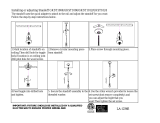
5
SAFETY PRECAUTIONS
Safety Precautions
Safety - English
WARNING: These Safety Precautions are
for your protection. They summarize
precautionary information from the
references listed in Additional Safety
Information section. Before performing any instal-
lation or operating procedures, be sure to read and
follow the safety precautions listed below as well
as all other manuals, material safety data sheets,
labels, etc. Failure to observe Safety Precautions
can result in injury or death.
PROTECT YOURSELF AND OTHERS --
Some welding, cutting, and gouging
processes are noisy and require ear
protection. The arc, like the sun, emits
ultraviolet (UV) and other radiation and can injure
skin and eyes. Hot metal can cause burns. Training
in the proper use of the processes and equipment
is essential to prevent accidents. Therefore:
1. Always wear safety glasses with side shields in
any work area, even if welding helmets, face
shields, and goggles are also required.
2. Use a face shield tted with the correct lter and
cover plates to protect your eyes, face, neck, and
ears from sparks and rays of the arc when oper-
ating or observing operations. Warn bystanders
not to watch the arc and not to expose themselves
to the rays of the electric-arc or hot metal.
3. Wear ameproof gauntlet type gloves, heavy
long-sleeve shirt, cuess trousers, high-topped
shoes, and a welding helmet or cap for hair
protection, to protect against arc rays and hot
sparks or hot metal. A ameproof apron may
also be desirable as protection against radiated
heat and sparks.
4. Hot sparks or metal can lodge in rolled up sleeves,
trouser cus, or pockets. Sleeves and collars
should be kept buttoned, and open pockets
eliminated from the front of clothing.
5. Protect other personnel from arc rays and hot
sparks with a suitable non-ammable partition
or curtains.
6. Use goggles over safety glasses when chipping
slag or grinding. Chipped slag may be hot and
can y far. Bystanders should also wear goggles
over safety glasses.
FIRES AND EXPLOSIONS -- Heat from
ames and arcs can start res. Hot
slag or sparks can also cause res and
explosions. Therefore:
1. Remove all combustible materials well away from
the work area or cover the materials with a pro-
tective non-ammable covering. Combustible
materials include wood, cloth, sawdust, liquid
and gas fuels, solvents, paints and coatings,
paper, etc.
2. Hot sparks or hot metal can fall through cracks
or crevices in oors or wall openings and cause a
hidden smoldering re or res on the oor below.
Make certain that such openings are protected
from hot sparks and metal.“
3. Do not weld, cut or perform other hot work until
the work piece has been completely cleaned so
that there are no substances on the work piece
which might produce ammable or toxic vapors.
Do not do hot work on closed containers. They
may explode.
4. Have re extinguishing equipment handy for
instant use, such as a garden hose, water pail,
sand bucket, or portable re extinguisher. Be
sure you are trained in its use.
5. Do not use equipment beyond its ratings. For
example, overloaded welding cable can overheat
and create a re hazard.
6. After completing operations, inspect the work
area to make certain there are no hot sparks or
hot metal which could cause a later re. Use re
watchers when necessary.
7. For additional information, refer to NFPA Stan-
dard 51B, "Fire Prevention in Use of Cutting and
Welding Processes", available from the National
Fire Protection Association, Battery march Park,
Quincy, MA 02269.
ELECTRICAL SHOCK -- Contact with
live electrical parts and ground can
cause severe injury or death. DO
NOT use AC welding current in damp
areas, if movement is conned, or if there is danger
of falling.




















